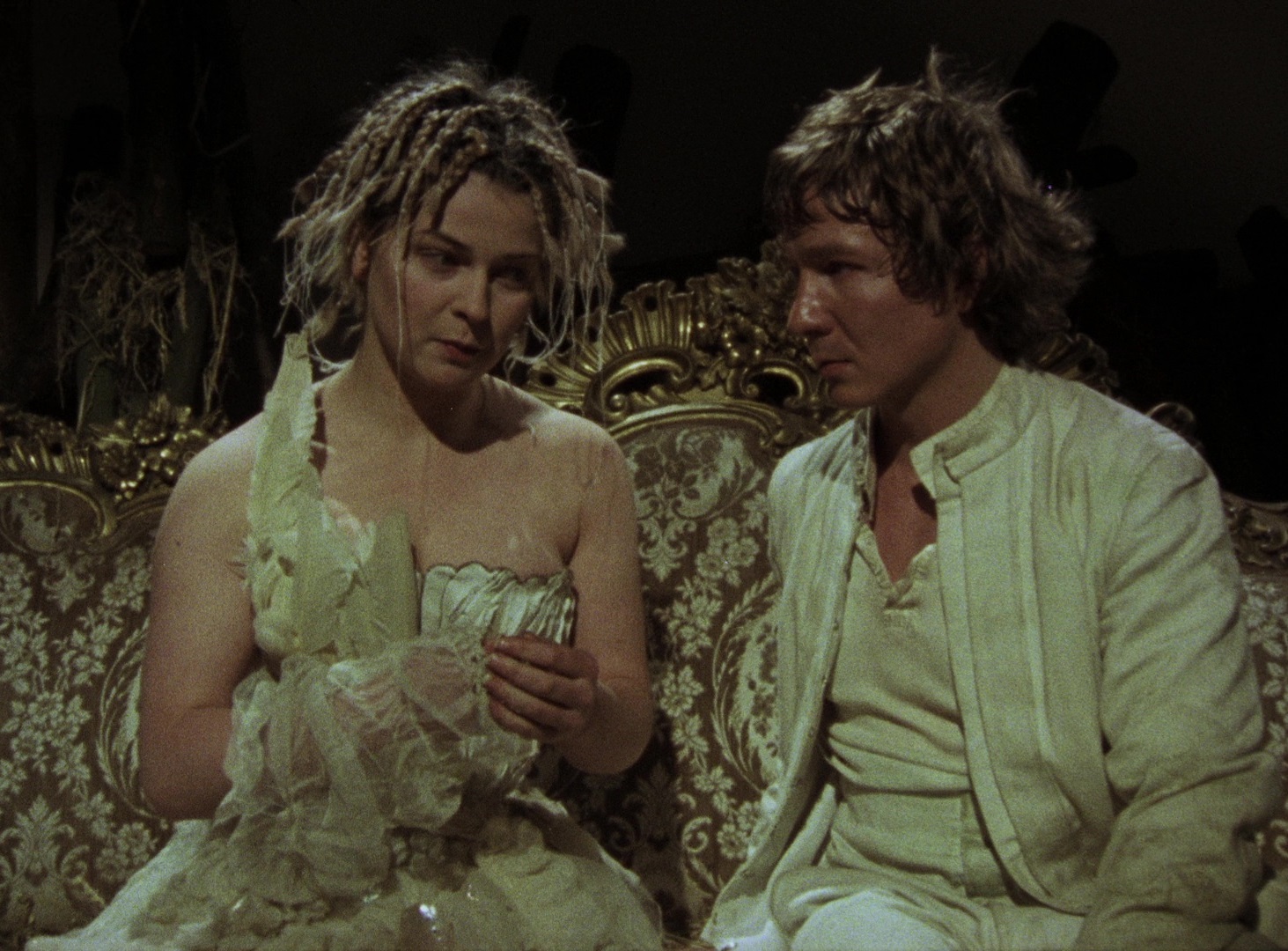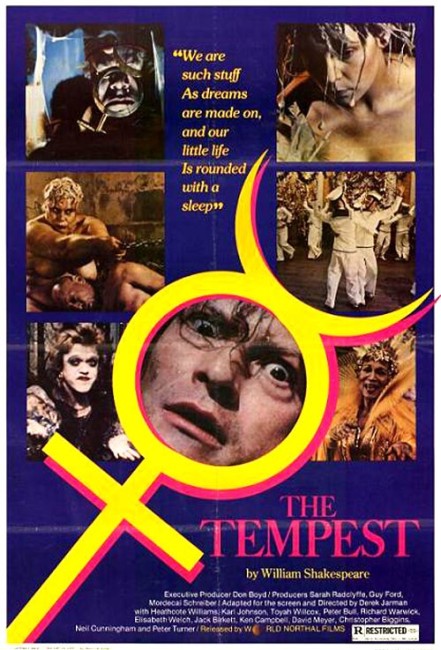Crew
Director/Screenplay – Derek Jarman, Based on the Play by William Shakespeare, Producers – Guy Ford & Mordecai Schreiber, Photography – Peter Middleton, Music – Wavemaker, Production Design – Yolanda Sonnabend. Production Company – Boyd’s Co.
Cast
Heathcote Williams (Prospero), Toyah Willcox (Miranda), Jack Birkett (Caliban), Karl Johnson (Ariel), David Meyer (Ferdinand), Richard Warwick (Antonio), Peter Bull (Alonso), Christopher Biggins (Stephano), Peter Turner (Trinculo)
Plot
Prospero, the former Duke of Milan, lives in exile on a small Mediterranean island with his daughter Miranda. Prospero is also a sorcerer and has ensnared the spirit Ariel, once the island’s lord. His idyll is threatened with the arrival of a ship containing his father and brothers. The ship is wrecked in a storm. Among the survivors, two drunken sailors, Trinculo and Stephano, are befriended by Prospero’s insane slave Caliban, the island’s original owner, who promises to lead them to Prospero in the hope of gaining revenge. At the same time, the naive Prince Ferdinand meets and falls in love with Miranda.
Derek Jarman (1942-94) was the English arthouse’s anarchist. Jarman was one of the few openly gay filmmakers during the 1970s and 80s and became an ardent AIDS activist after being diagnosed in 1986. He studied at art school, designed sets for various ballet and opera and then took his first film job as a production designer, creating the striking white tiled sets for Ken Russell’s The Devils (1971), before branching out as a director. He would make eleven films in all. His visions range from the doomed anarchist futures of Jubilee (1978) and The Last of England (1987) to Sebastiane (1975), a gay religious epic in Latin. At times, Derek Jarman’s films seem like the intellectual gamesmanship of a Peter Greenaway shot through with a punk ethos.
Jarman’s later films moved away from the brattish punk defiance of his earlier works to classical arthouse pieces such as Caravaggio (1986), a biography of the 17th Century Italian artist; Edward II (1991) from Christopher Marlowe’s play; and Wittgenstein (1992), a biopic of the early 20th Century philosopher. Most of Derek Jarman’s films were biopics of gay figures or based on works by gay writers. His final film was Blue (1993), which eccentrically featured nothing except a blue screen and Jarman’s narrated observations on the soundtrack. In between films, Jarman also directed various music videos and published several of his own journals. He was also known as an artist and even for his skills as an avant garde gardener.
The Tempest is, if anything, punk Shakespeare. In fact, Shakespeare hardly gets a look-in, with the play only serving as backdrop to Derek Jarman’s compulsively weird imagery. Jarman has wilfully rearranged and deleted sections of the play. Vital chunks of Shakespeare – the whole Prospero/Miranda obsession, for instance – are neglected. Indeed, Shakespearean purists usually give the film the thumbs down, so the best way to approach the film is to ignore Shakespeare altogether.

The film is like a journey through a haunted house where all the characters and the very dwelling itself are verging on madness – the two sailors Trinculo and Stephano’s passage through the rooms of the house takes on a dark, dream-like quality. (All the interiors were shot at the gloomy Stoneleigh Abbey in Warwickshire). The film is lit in a shadowy atmosphere that frequently verges on the monochrome. It seems at times to be a trip through a whacked-out dress-designer’s attic, where costumes from modern and period different eras mix, where statues stand draped in formal clothing and stylised porcelain Japanese masks, and where painted dwarves dance.
The film is filled with striking images – a delicate Ariel all-in-white who stands clicking the teeth of a miniature skull, whispering in poetry to call a man about to be killed to awaken; the obscene images of Caliban sucking the nipple of the grossly overweight witch Sycorax; haunted voices that call to Prospero in his sleep; the exquisitely lit image of Toyah Willcox on a rocking horse, all in monochrome. Jarman turns the play’s wedding climax into a song-and-dance number where stage singer Elizabeth Welch delivers a rendition of Stormy Weather. Forget Shakespeare, but watch this haunting, compulsively offbeat film.
The film is certainly eccentrically cast – Jarman’s Prospero, Heathcote Williams, was apparently a real-life stage magician. Jarman casts many actors from his other films – most notably Jack Birkett and .singer Toyah Willcox, who makes for a decidedly less-than-innocent Miranda in Jarman’s interpretation.
Other adaptations of the The Tempest include:– the famous Forbidden Planet (1956), which relocated the story in science-fictional terms; Paul Mazursky’s modernised Tempest (1982); Peter Greenaway’s eccentric Prospero’s Books (1991); The Tempest (1998), a tv version that locates the story during the American Civil War; and Julie Taymor’s visually fantastical The Tempest (2010) with a female Prospero.
Clip from the film here

